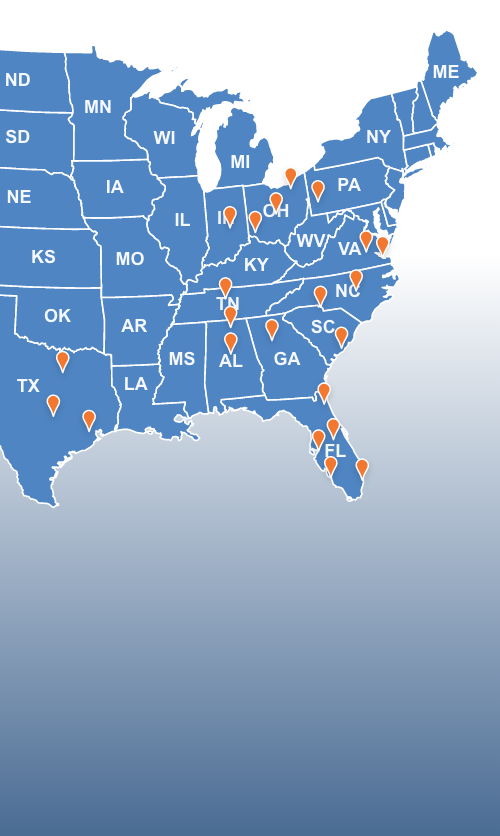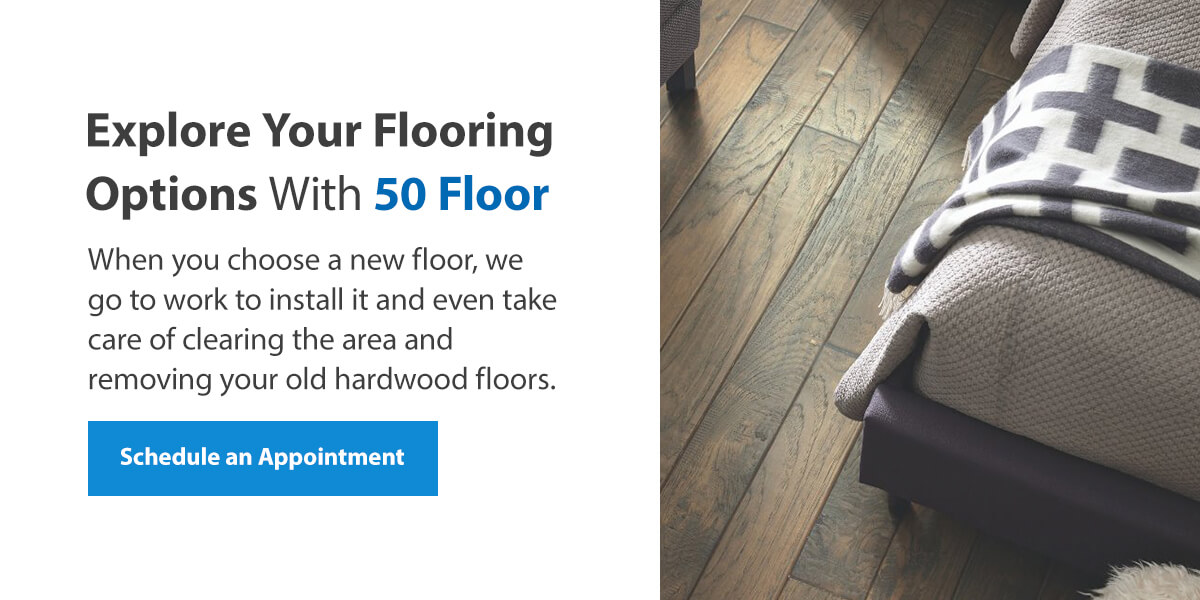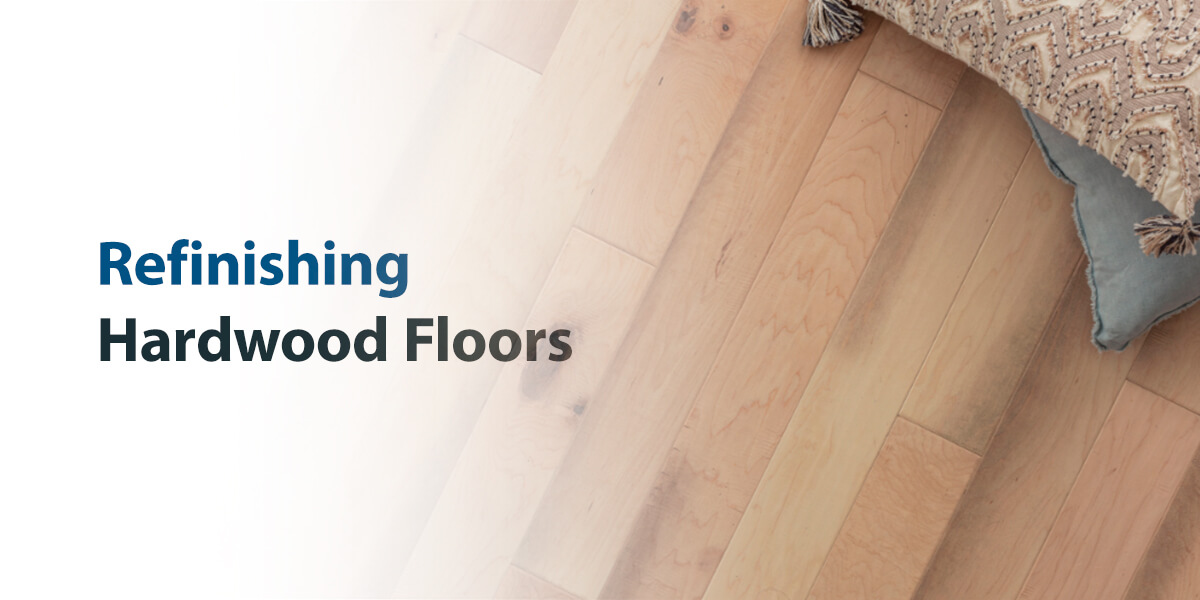

Hardwood floors can be a source of timeless beauty in homes. They aren’t just beautiful, either. Hardwood floors have some serious practical benefits, such as their durability and resistance to allergens. It’s no wonder, then, that hardwoods have become especially popular for modern homeowners, which has motivated some to pull up that old carpet to see what’s underneath. Finding old hardwoods can feel like you’ve discovered a goldmine, but typically the floors will need to be refinished.
It isn’t just hardwood floors that have been hidden away for decades that need to be refinished. There are many occasions, including normal wear and tear, that call for refinishing your wood floors. When it comes time to breathe new life into your floors, you may wonder about the best way to refinish hardwood floors. Discover the answers below and learn when refinishing your floors isn’t the best course of action and when you should, instead, replace them with new floors you love.
What Are the Benefits of Refinishing Hardwood Floors?
For many aspiring homeowners, hardwood floors are at the top of their dream home wish lists. Genuine hardwood showcases an authenticity that creates a warm and welcoming environment. Hardwood floors maintain their timeless and elegant aesthetic for years and even decades into the future. But genuine wood flooring is not immune to wear and tear. Whether you own a century-old Victorian or modern ranch, there will always come a time when you will have to refinish your worn, aged hardwood floors.
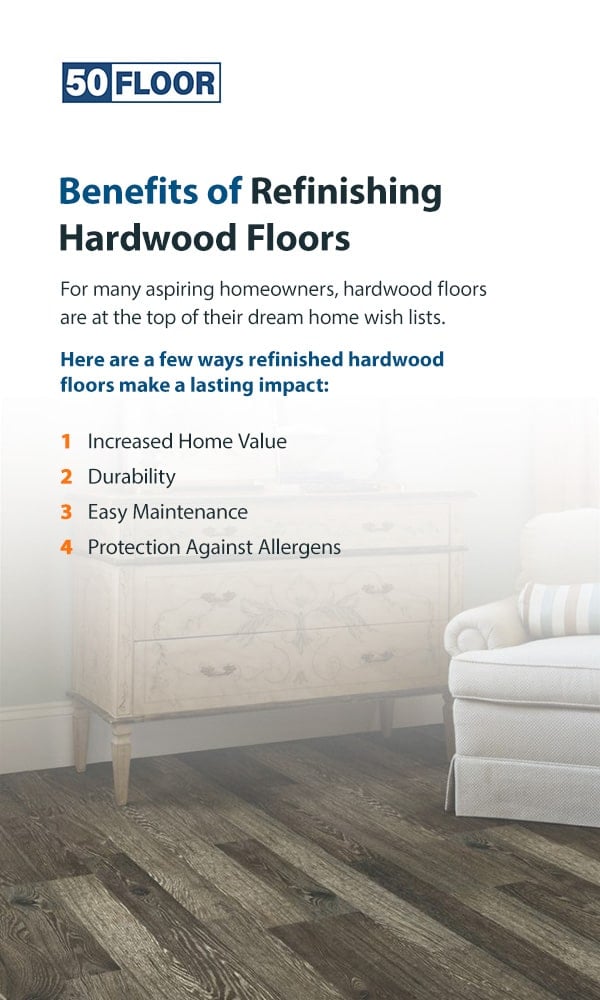

While no one likes the costs that come with making changes at home, the long-term benefits of refinishing old hardwood flooring far outweigh the short-term inconveniences. Here are a few ways refinished hardwood floors make a lasting impact:
1. Increased Home Value
Hardwood floors are an investment in your home. Since many homebuyers prefer hardwood flooring, your home will sell for a higher price when listed on the market. In addition, the government views hardwood floors as a capital improvement. This means that you can pay less in taxes when you sell your home, depending on your state.
2. Durability
Hardwood flooring is a renewable resource that can be refinished several times and still maintain its integrity. This benefit means hardwood can last for generations.
3. Easy Maintenance
One of the greatest benefits of hardwood flooring is that it’s easy to clean. If someone spills their drink, all you have to do is wipe the floor. Refinished hardwood doesn’t stain from coffee, wine or anything else. This means unless there is serious water or structural damage, any mess will be that much easier to clean up. Dusting, mopping and drying are all it takes to clean the floor.
4. Protection Against Allergens
According to the American Lung Association, hardwood floors are better for your overall health than carpets. Carpeting traps more dust, pollen, dirt, mites and other allergens than any other type of flooring. Wood flooring keeps pollutants on the surface to easily clear away, especially with a smooth, refinished surface. Even if you don’t suffer from allergies, you will see an improvement in your indoor air quality and general well-being.
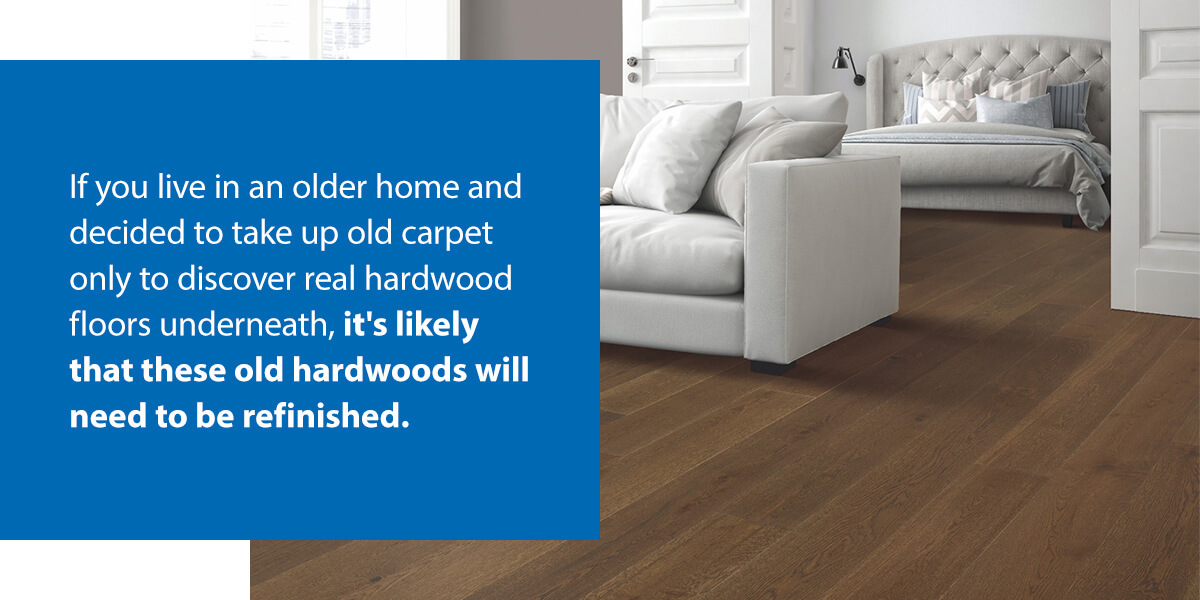

When Should You Refinish Hardwood Floors?
With those benefits in mind, let’s talk about when you should refinish your hardwood floors. In some cases, it may be obvious. If you live in an older home and decided to take up old carpet only to discover real hardwood floors underneath, it’s likely that these old hardwoods will need to be refinished. If you currently have exposed hardwoods in your home, then the answer may be less apparent. Here are a few indicators that it’s time to refinish those hardwoods:
- The floor is scratched or dented: Normal foot traffic, kids playing with toys and pets can all lead to wear and tear that will eventually merit refinishing your hardwood floors. If you see scratches or even small dents, this is a good sign that your floors should be sanded down and refinished. You’ll see those scratches and dents disappear in no time.
- The floor is discolored: Another sign you may need to refinish your hardwood floors is if they’re discolored. Discoloration usually occurs because there’s too much direct sunlight hitting your floors. Your floors can also become discolored from water damage. If your floors have been severely water damaged, they should be replaced rather than refinished.
- The finish doesn’t match your style: It isn’t just damage that should warrant refinishing your floors. Since floors can be stained in a variety of colors and shades, your floors may not match the rest of your furniture or your preferences. When this is the case, don’t just put up with what you have. You can refinish those floors and choose a perfect stain or a beautiful natural finish.


How Much Does It Cost to Refinish Hardwood Floors?
With any home improvement project, expense tends to be a concern. Sure, you would love to see beautifully refinished hardwoods throughout your home, but what is it going to cost you? The answer depends on a few different factors, including:
- Whether you DIY or hire a professional
- What kind of hardwood floors you have
- What condition the floors are in
- How much area the floor covers
- Whether you refinish and stain floors or just refinish them
- Whether you need to refinish stairs
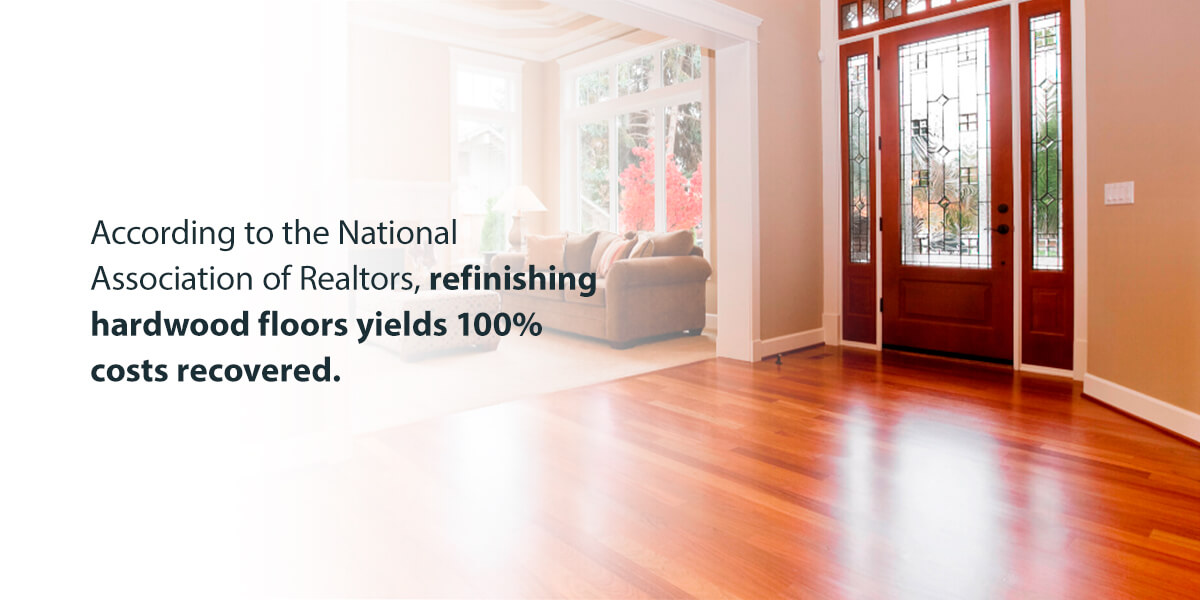

Though all of these factors can substantially affect the cost to refinish old wood floors, a good reference point is that it typically costs between $1.50 and $7 per square foot to refinish hardwood floors. This includes the cost of labor and materials to have a professional sand down your floors and refinish them.
The lower end of that estimate may seem like a great price, but it can quickly get expensive if you’re refinishing a large area, and especially if you’re refinishing your whole home. If your home is 1,500 square feet, for instance, and you want to refinish the floors throughout your entire house, that could cost anywhere from $2,250 to $10,500.
If you’re looking to sell your house and want to make it more appealing by refinishing your hardwood floors, the good news is, you can recoup the entire cost. According to the National Association of Realtors, refinishing hardwood floors yields 100% costs recovered.
If you’re not looking to sell and you’re concerned about cost, you could forgo hiring a professional and do the job yourself. This is certainly a viable option if you want to refinish your hardwood floors on a budget. We’ll talk more about the pros and cons of DIY next.
Should You DIY or Hire a Professional?
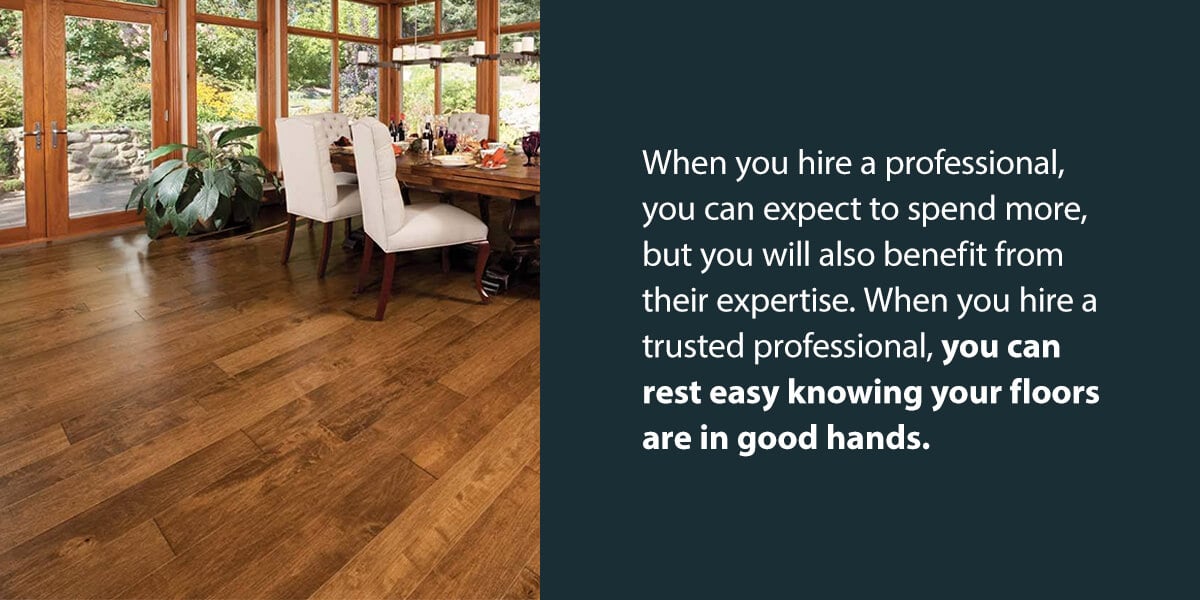

If you’re concerned about the cost to refinish your hardwood floors, you may be wondering how feasible it is to tackle the job yourself. If you enjoy taking on home improvement projects and have the time, you could learn how to how to refinish old hardwood floors yourself.
However, it’s important to understand precisely what you’re getting into before you choose to take on the job yourself. Especially if you’re planning to refinish the floors in more than one room, let alone your entire house, you may want to think twice about trying it on your own.
As tends to be the case for many of us when we decide to try a project on our own, you may end up running into problems due to your lack of professional experience. Unlike smaller-scale DIY projects, making mistakes in the refinishing process could lead to irreparable damage.
If you’re planning to do it yourself to save money, keep in mind that you’ll have to purchase materials and rent an industrial sander. Most DIYers will still come out ahead financially compared to if they have hired a professional, but it may not be by as much as you expect. Find out exactly what you would have to spend either way to determine whether the savings are worth the hassle.
When you hire a professional, you can expect to spend more, but you will also benefit from their expertise. When you hire a trusted professional, you can rest easy knowing your floors are in good hands. You can also literally rest easy if you hire someone who takes care of all the prep work, such as moving furniture.
Schedule Your In-Home Consultation
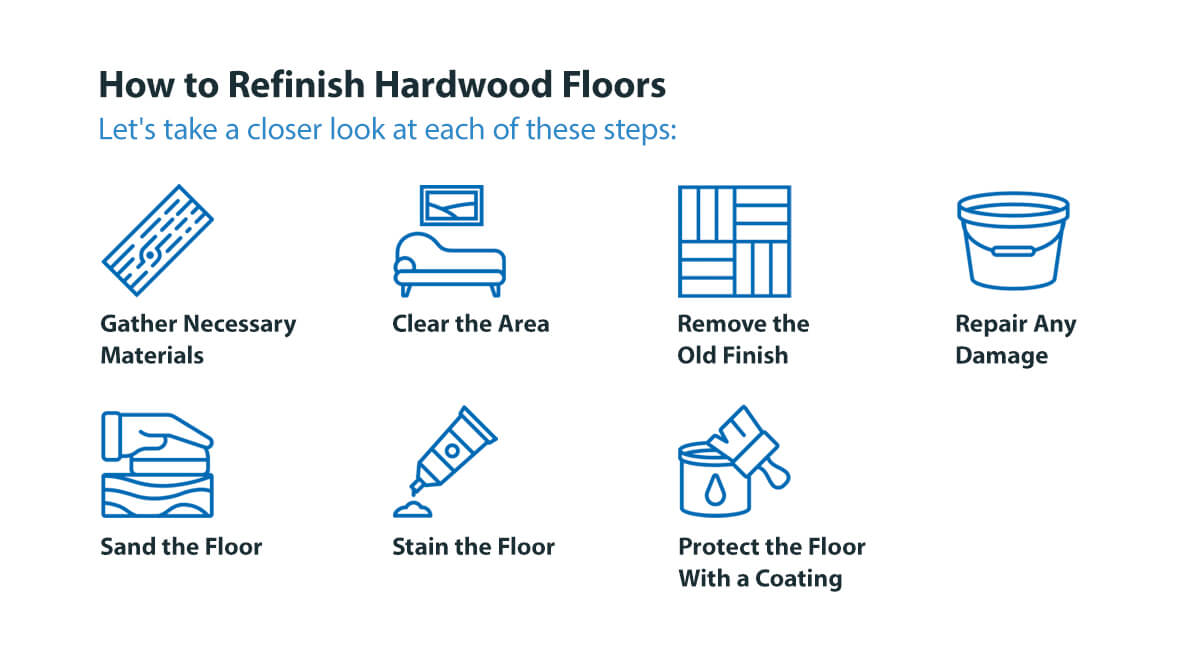

How to Refinish Hardwood Floors
If you decide to refinish your hardwood floors yourself, you’ll want to become well-educated on the process. The basic steps come down to the prep work, removing the old finish, sanding, staining and finishing. Let’s take a closer look at each of these steps:
1. Gather Necessary Materials
Before you start clearing the room, you have to prepare for the refinishing process. Here is a list of everything you will need to complete this home improvement project:
- Floor sander
- Small pry bar
- Edge sander
- Sander pole
- Sandpapers of 40-120 grit
- Tarp
- Painter’s tape
- Wood filler
- Spackle knife
- 120 grit sanding screen
- Shop vacuum
- Tack cloth
- Denatured alcohol
- Stain and finish
- Steel wood pads
You’ll also want protective gear like a half-mask respirator, goggles and ear protection. Consider wearing old clothes or paint coveralls, especially for the staining process.
2. Clear the Area
To prep for refinishing your floors, you’ll need to clear the room you plan to work in. This includes more than furniture and other objects on the floor. You should also remove wall hangings and curtains so the room is completely clear. Using a plastic tarp, cover windows and doorways. This keeps dust from spreading throughout your home.
3. Remove the Old Finish
In some cases, your next step will be to buff, or screen, the floor. This step involves using a screen, a sanding disk that is designed to resist clogging, to remove the old finish. Note that this step only applies to certain situations. Floors that were previously finished with a non-waxed polyurethane and were not stained can and should be screened. You should also only screen if the wood itself is in good shape, even if the finish is scratched or dull.
4. Repair Any Damage
You can’t learn how to refinish hardwood floors yourself without learning how to repair them, as well. While scratches are easy to buff out, you’ll need a bit more elbow grease to tackle holes and large cracks. If your floors are significantly damaged, use a trowel wood filler that is thin enough to spread across the entire area that needs patching. For smaller spots that need individual attention, you can use a wood patch filler to quickly fix them.
For best results, allow the filler to completely dry before wiping down the floor with a damp rag. Now you’re ready to start sanding.
5. Sand the Floor
If your floors are in good shape and were not finished with a wax coating, then you may not have to sand them. However, any time you’re dealing with floors that are coated with wax or are scratched, then you need to sand them down to get them smooth. You can rent a sander to do this job yourself, but be careful not to gouge the floor or sand unevenly.
If you want to make it easier to see where you’ve sanded and where you still need to cover, make some marks at certain intervals on your floor with a pen or pencil. As you sand over an area, the mark should get erased, so anywhere you see a mark is an area you haven’t been over yet. This tip can be especially helpful once you’ve sanded off the top layer with stain and are going over the floor again.
6. Stain the Floor
When you’re left with a floor that is just smooth, bare wood, you now have the option to stain the floor. If your floors are made from a high-end wood like mahogany, walnut, cherry or maple, then you may want to think twice before you stain them. These exotic woods tend to have a beautiful color on their own and don’t take stain very well.
If you have a more typical wood flooring material, like red or white oak, you can decide whether you want to leave the natural color. You could opt for a stain that will make your floors look more like one of the high-end woods previously mentioned.
If you choose to stain your floor, you can select any color that works well with your decor. You may need to apply several coats of stain and sand the floors in between each coat. It’s usually a good idea to call in the professionals if you want to stain your floors.
7. Protect the Floor With a Coating
Finally, you’ll want to protect your floors to preserve the beautiful appearance you achieved through refinishing. There are a few different options for coatings you can apply to protect your floors. The type of finish you decide to use will depend on your needs, timeline and overall preference.
Which Hardwood Floor Finish Is Best for You?
The finish is the most important part in learning how to refinish hardwood floors. When adding the last layer of protection, you don’t want to compromise on quality. This is the final touch that will tie the entire space together. There are several types of finishes to choose from, all offering their own advantages depending on your needs and preferences. Here are the most common and recommended types of hardwood finishes:
- Water-based polyurethane: This is one of the most popular and costly finishes available, but for good reason. Water-based polyurethane dries within a few hours and won’t yellow over time. While some people prefer a glossy finish, this option also comes in satin and semi-gloss. Water-based polyurethane is an environmentally friendly option, releasing fewer volatile organic compounds (VOCs) than other finishes. Just make sure you buff the floor of any small scratches, or they will show through.
- Oil-based polyurethane: For hardwood floor refinishing, an oil-based finish is a great option for its durability and affordable cost. It works best for high-traffic areas because it is water-resistant and easy to maintain. Oil-based polyurethane will adopt a warmer hue over time, which may add to the aesthetic of some hardwoods. Applying polyurethane that is oil-based will require a longer drying period and emit a strong odor when wet.
- Wax: Before the 1960s, wood floor refinishing used to be done with almost exclusively with wax. It produces a low-sheen finish that is easy to apply and touch up. It has a lighter odor, fewer VOCs and dries quickly so you can walk on it after just a few hours. However, wax isn’t as durable as some of the other finishes and will slowly darken over time.
- Shellac: If you are looking to restore old hardwood floors with a natural product that has the lowest amount of VOCs, shellac may be the best option. It’s a sustainable product that easily and smoothly adheres to oily tropical woods. On the flip side, shellac takes longer to apply, as it requires attention to detail to coat the wood evenly with this product.
- Acid-cured finish: Also known as a “Swedish finish,” acid-cured finish is considered to be the best of the best. Although the cost of refinishing will be higher, the end result is always beautiful. An acid-cured finish is stronger than any polyurethane and is highly resistant to chemicals, scratches and heavy foot traffic. It protects your floor while highlighting the floor’s beautiful wood grain patterns. However, it is high in VOCs and always requires an expert’s hand.
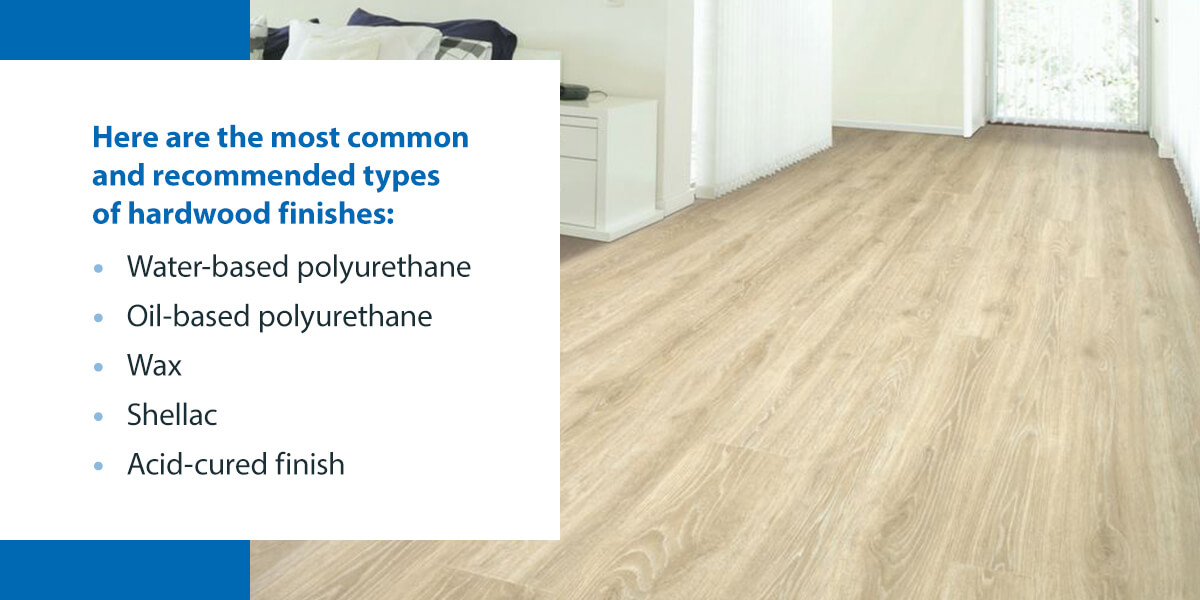

How Often Do You Refinish Hardwood Floors?
When you invest the time and money to refinish your floors, your next question will probably be how often to refinish wood floors. The answer depends on how old and how thick the floors are and on how much wear and tear your floors experience.
Every type of wood is different, so if you have access to the manufacturer’s instructions, you should consult those to see how often the floors should be refinished. Keep in mind that if you have engineered hardwood, which is made from bonded layers of thin wood planks, you can still refinish it. But it can’t handle being refinished as often as solid plank hardwood floors can.
A rule of thumb to go by is that most hardwood floors need to be refinished every seven to 10 years. If you have kids and pets, your floors may be ready to be refinished after just three to four years. Pay attention to the appearance of your floors and determine when they show enough wear that they should be refinished. If your floors have reached the end of their lifespan, then you will need to replace them instead of repair them.
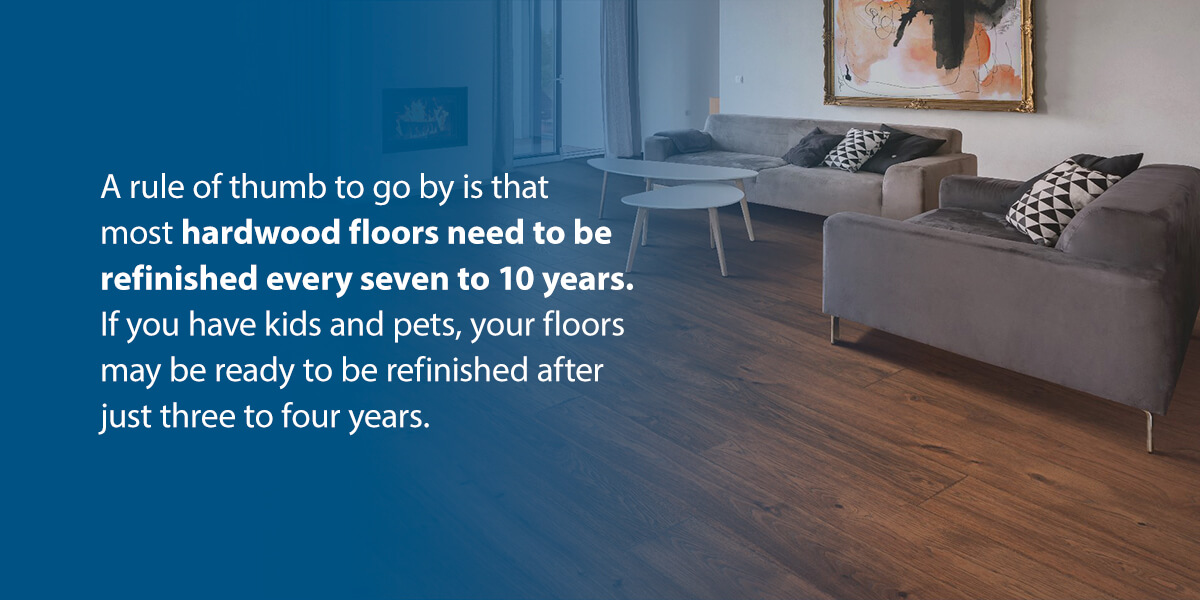

When Should You Replace Your Floors Instead of Refinishing Them?
Refinishing your hardwood floors isn’t always the right option, or it may not be an option at all. So, how can you determine when you need to replace your floors? Refinishing won’t be enough if your floors are:
- Too thin: Some hardwood floors are only one-quarter of an inch thick, which is too thin to be sanded and refinished. Even if your floors started out thicker, they become thinner each time they’re refinished, so they will eventually become too thin to be refinished again. If you’re not sure how thick your wood floor is, remove a section of trim or an air vent so you can see a cross-section of the floor.
- Water damaged: Spilling a glass of water on the floor and drying it up does not constitute water damage. Serious water damage tends to come from flooding due to severe weather or a plumbing issue. Whatever causes it, when your floors are water damaged, they need to be disposed of and replaced. Water causes wood to rot, so refinishing it isn’t enough to restore it.
- Structurally damaged: Scratches are one thing, but if you have more severe damage that goes beneath the surface, then you need to replace your floors. This type of damage could include cracks, deep gouges or warping. Any of these issues won’t be remedied by refinishing the floors. In some cases, you may be able to replace only a section of your floor and refinish the rest.
- Unstable: Some floors may also have issues like gaps between boards, loose boards or too much movement when you walk across the floor. When a floor isn’t securely constructed, then you have underlying issues a professional needs to look at. They may be able to fix the floor so that you can refinish it, but in other cases, you’ll need to replace the floor.
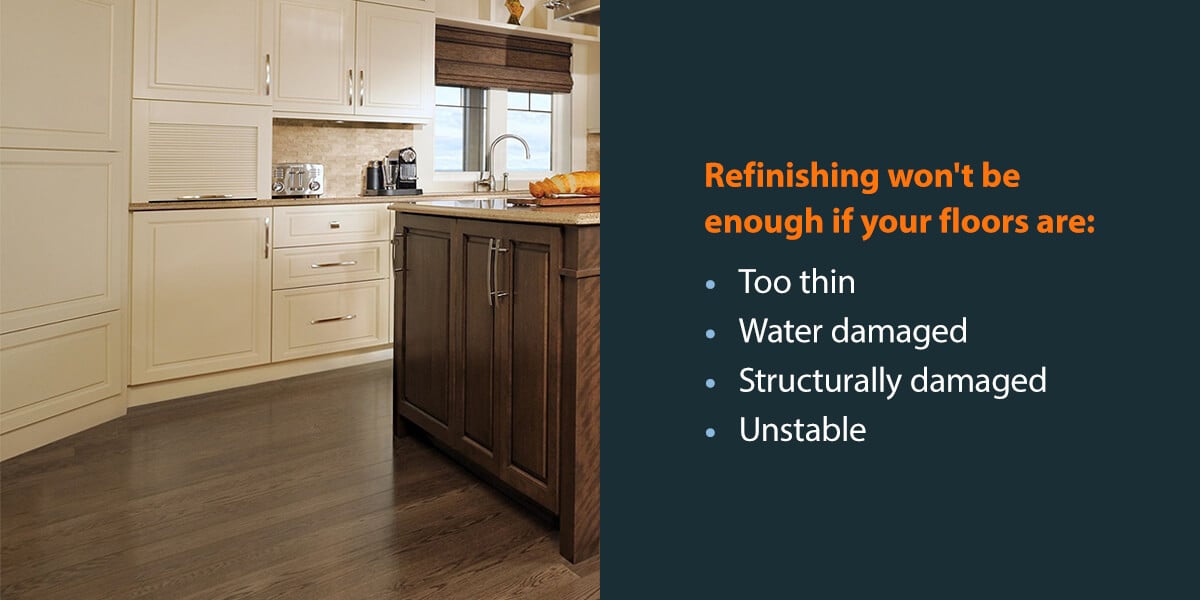

Explore Your Flooring Options With 50Floor
When refinishing your hardwood floors isn’t enough and it’s time to put in new flooring, you enjoy the benefit of getting to choose floors that fit in perfectly with your lifestyle and preferences. However, the options can feel overwhelming. Should you put in new hardwood, laminate, luxury vinyl tile, vinyl or carpet? Once you make that big decision, there are endless options for customization.
Rather than wander through hardwood and flooring stores searching for the right option, let 50Floor come to you. We bring the options to your home to make selecting the best flooring for your space a simple and enjoyable experience. When you choose a new floor, we go to work to install it and even take care of clearing the area and removing your old hardwood floors.
If you want to turn the task of replacing your flooring into a fun and easy experience, schedule an appointment with 50Floor today.


